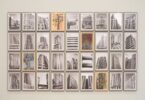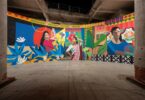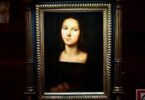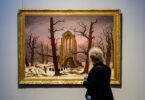William Parry
The sea is a central, unifying motif in Palestinian artist Inass Yassin’s latest exhibition, Sparkling Cities– running at Zawyeh Gallery in Ramallah until June 24.
It is a jarring, visual journey that explores how the “concrete” transformation of public spaces in cities such as Ramallah, Beirut and Alexandria has severed a collective cultural, social, aesthetic and environmental resource known to, and beloved by, millions across the Arab world.
The show cleverly achieves this by loosely tying its 19 images together via visual references to the 1969 classic Egyptian film, Abee Fawq Al Shajara, which stars Abdel Halim Hafez and Nadia Lutfi.
This referential (and culturally reverential, or at least deeply nostalgic) basis is neatly established in the opening three images, Negative I, Negative II and Negative III, which were taken by Yassin inside the screening room of one of Ramallah’s cinema houses – a cinema that was demolished early in the 2000s to make way for a new real estate development.
The images contain several references to destruction – a gun, a screwdriver and a switchblade are drawn on the wall of Negative I – and the iconic photograph of the Palestinian child, Faris Odeh, taking aim at an imposing Israeli tank with a rock in hand is present in Negative I and II (most viewers will know that the 14-year-old boy was shot and killed days later by an Israeli soldier, with Odeh becoming an enduring image of Palestine’s David-and-Goliath resistance to Israel’s colonisation and military occupation). These leave a strong “negative” sense of foreboding.
:quality(70)/cloudfront-eu-central-1.images.arcpublishing.com/thenational/CSPTM5IIIBB6HML3IXPXDNJ7VY.jpg)
Negative III includes a smiling image of Gamal Abdel Nasser and a familiar poster image of the two stars from Abee Fawq Al Shajara, which was in the window of the cinema house before its demolition, a bitter irony that clearly resonated with Yassin.
The role of cinema houses in shaping an enduring image of Arab coastal cities like Beirut and Alexandria, and Arab social and cultural life for several generations, was profound, she believes. Like so much of what the film itself celebrated, they too have been largely lost to vast real estate developments – which have transformed the corniches and squeezed out the customary social habits and gatherings associated with them, like picnics on the beach or in city parks.
“That was a very iconic movie that was screened and projected in many cinema houses in Palestine and the Arab world. It had the spirit of this modern Arab culture where in the late ‘60s, people had this notion of an Arab cultural identity, the Arab dream of having the ‘Watan Al Arabi’, all the Arab countries as one homeland. The social life that generation experienced was also reflected in that movie on many levels.”
Several pieces from Sparking Cities contain direct references to Abee Fawq Al Shajara – Flying Umbrellas alludes to the twirling parasols used while Abdel Halim Hafez memorably sang Dokko El Shamasy.
And naturally the Raouche – Beirut’s famous “Rock” – is central to many of the pieces. Starry Night includes a tiny figure of Nadia Lutfi, whose belly dance attire in the film created bright dancing reflections, which Yassin later had in mind as she was captivated by the beautiful, glittering water around the Rock.
:quality(70)/cloudfront-eu-central-1.images.arcpublishing.com/thenational/SZF5IPJWKFBPVMDPZ2W3RUR7LQ.jpg)
The paintings are predominantly dark and dense, which creates a visually overbearing, aggressive mood. Brightly coloured picnic chairs, beach umbrellas and a kite in three of the paintings appear small and fragile in comparison to the towers in many of Yassin’s paintings, and much of the sea itself is dark and threatening – as if the “concretisation” and privatisation of so much once beautiful and publicly accessible coastline in Lebanon and Egypt (particularly) has also transformed the once scintillating, coastal waterfronts in an unnatural way.
They evoke “a sense of agony for the sense of loss,” Yassin says, a displacement of a widely shared social and cultural reference point that was dear to many generations.
Other pieces, like Rock I–III, are visual interpretations of the Rock, cross-sections of its “anatomy”, says Yassin, and reflect the ways in which the various elements (including salt, water and time) alter its nature and appearance. Interacting with the Rock – observing it from land, touching it in the water, and going “inside its stomach” by boat – enables one to appreciate “its organic patterns”, says Yassin, and these paintings embody that sense.
Set adrift evokes a sense of profound loss, with the Rock “detached” and drifting off into the sea – Yassin expresses concern about its fragility amid so much development and alteration to the physical landscape. But metaphorically, it is now cut off from ordinary people. “In a sense, it’s been cast away, it’s losing its iconic position, emotional, historic and environmental,” she believes.
:quality(70)/cloudfront-eu-central-1.images.arcpublishing.com/thenational/K4L6524USJH5FKDP4R2J4HUS7Q.jpg)
For Yassin, the concrete transformation of her home of Ramallah, and Israel’s network of walls, towers and checkpoints, have made the sea inaccessible, visually and literally. Burj Falastine, Black Towers and Forest represent these elements and question the value and wisdom of the building frenzy at the expense of micro environments, green, public places and views of the sea. The colours and symbols convey humour, playfulness and resilience in the face of oppression and commercialisation and – in the case of Burj Falastine – laughable irony.
The technique that Yassin uses in these paintings embodies the very theme that runs throughout them of transformation and destruction.
“I try to imitate what is happening in the city in the way that you see all these layers: I would build layers in a way, then I would destroy and rebuild them. I don’t work on one painting until it’s done; rather, time becomes part of the process because, as an artist, experimenting with the material, you want to employ the material in the way that you change the material.
“This work began in a way that the destruction and layering are part of the picture. It’s not a picture in which you have a narrative and you look to read the narrative. It’s more about the feel of the material that tells you about the layering and time in creating that picture.”
Sparkling Cities is an exhibition about discussing the profound social, cultural and political interactions that have swept across much of the Arab world in recent decades. There is a clear sense of nostalgia and a sadness around the loss of what this period symbolises to Yassin and millions of others, but not a resistance to change per se. Respect for the natural environment, equitable access to it, and the building of social, societal and cultural interactions around it are issues that her work brings into the debate.
“The perspective I see my work through is about how artists within a certain context develop their own artistic language. It’s about expanding the artistic language practice, making pictures and creating a debate about that,” says Yassin.
Courtesy: thenationalnews







